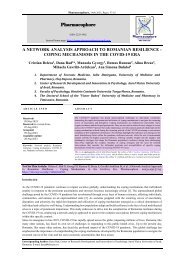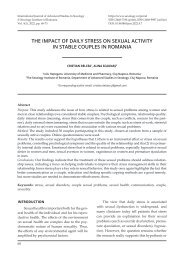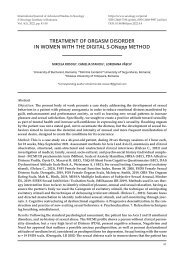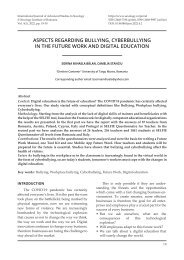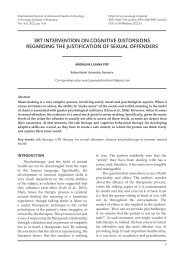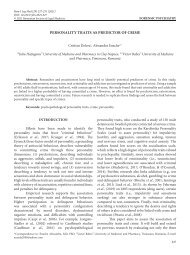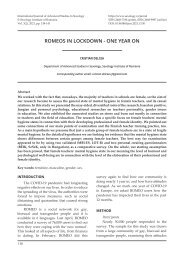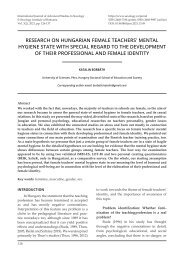297-301
Create successful ePaper yourself
Turn your PDF publications into a flip-book with our unique Google optimized e-Paper software.
Rom J Leg Med [30] <strong>297</strong>-<strong>301</strong> [2022]<br />
DOI: 10.4323/rjlm.2022.<strong>297</strong><br />
© 2022 Romanian Society of Legal Medicine<br />
GENERAL PURPOSES<br />
GIRLS PLAYING VIDEO GAMES AND THEIR DEDICATION TOWARDS GAMES<br />
Cosmin Ghețău 1,* , Dan Octavian Rusu 2 , Cristian Delcea 3<br />
“Babeș-Bolyai” University, 1 Faculty of Sociology and Social Work, 2 Faculty of Psychology and Educational Sciences,<br />
3<br />
“Iuliu Hațieganu” University of Medicine and Pharmacy, Cluj-Napoca, Romania<br />
Abstract. Numerous works indicate an equal distribution among video game players in regard to gender distribution,<br />
yet in literature, there is still not a consensus regarding what a gamer really is and, as a result, the sampling method can be<br />
ambiguous bringing into question the real gender distribution among video game player population. In the present paper, we<br />
attempt to assert the seriousness with which games are approached by gender based on the hardcore gamer typology, in this<br />
regard we draw from the literature classification of gamers into hardcore and casual in an attempt to better understand the<br />
gender distribution in video games. In doing so, we used the Casual Hardcore Gamer Assortment scale (CHG) on a sample<br />
of 996 video game players. Results indicate a positive correlation between CHG and gender. Based on this correlation we<br />
can assume that although girls do play video games there are still differences in their engagement towards these games, girls<br />
seem to invest less time and economical resources in video games and take games less seriously when compared to their male<br />
counterparts.<br />
Keywords: video games, gamer girl, video games demographics, gaming.<br />
INTRODUCTION<br />
Gamers’ population and its dynamic are<br />
especially relevant in the present world when video<br />
games are the biggest and most profitable entertainment<br />
industry (Deleuze et al., 2019; Entertainment Software<br />
Association, 2021). According to the Interactive<br />
Software Federation of Europe (2020), half of the<br />
European Union’s population (51%) currently plays<br />
video games, which means about 250 million players.<br />
Similar to data from the United States, a considerable<br />
proportion of players are women, namely 45%<br />
(Interactive Software Federation of Europe, 2020). These<br />
demographic data provided above have limitations in<br />
understanding the real number of girls that really prefer<br />
video games as their main method of entertainment. In<br />
most reports’ gamers are vaguely defined, as is the case<br />
in the report from electronic software associations that<br />
consider a gamer any person who invested one hour or<br />
more per week in video games (Entertainment Software<br />
Association, 2020).<br />
The present paper does not discuss the<br />
difference in skills between genders in video game<br />
skills as we consider that there is nothing to discuss<br />
on this topic as numerous studies demonstrate there<br />
is no difference in essential abilities required by video<br />
games (Walkerdine, 2007; Greenberg, Sherry et al.,<br />
2010) like cognitive abilities (Fran & Lori, 2004) or<br />
biological one’s alike response times (Shen et al., 2016)<br />
or multitasking (Lui, Yip, & Wong, 2020). Nevertheless,<br />
there is still a prejudice that girls are performing worse<br />
than boys in video games (Ruvalcaba et al., 2018; Kaye,<br />
Pennington, & McCann, 2018), although this is not<br />
true it might influence the demographic of the gamer’s<br />
population. Girls often need to prove their abilities<br />
in competitive games this putting them in a difficult<br />
position and reducing the number of girls playing these<br />
games (Walkerdine, 2007; Greenberg et al., 2010; Nardi,<br />
2010; Ruvalcaba et al., 2018; Kaye et al., 2018). Studies<br />
even indicate that girls are more prone to be exposed<br />
to sexual harassment in online gaming compared with<br />
boys (Walkerdine, 2007; Ruvalcaba et al., 2018; Tang,<br />
Reer & Quandt, 2020). Based on this data, we question<br />
the actual number of gamer girls engaged in video<br />
games, although there may be an equal distribution<br />
among video game players in general, it is very likely<br />
that girls avoid those complex games that we usually<br />
think of when we imagine a gamer. Moreover, girls<br />
*Correspondence to: Ghețău Cosmin, “Babeș-Bolyai” University, Faculty of Sociology and Social Work, Cluj-Napoca, Romania,<br />
E-mail: cosmin.ghetau@ubbcluj.ro<br />
<strong>297</strong>
Ghețău C. et al.<br />
may tend to avoid online games, those games that are<br />
praised for their community and the social elements<br />
in them. A hesitation that can be to some degree<br />
observed in studies reporting different in-game times<br />
between gamer boys and girls, the latter spending less<br />
time in games compared to boys (Twenge & Martin,<br />
2020; Leonhardt & Overå, 2021; Barr & Copeland-<br />
Stewart, 2022). This reluctance to play online games<br />
is unfortunate, as discussed before girls have the same<br />
aptitude in games, additionally, they also can be very<br />
good teammates in online games there is proof that<br />
girls bring advantages in video games especially the<br />
group cohesion an essential advantage in competitive<br />
group vs group online games (Kim et al., 2017).<br />
We consider the approach of the simple<br />
intention to play insufficient towards the real<br />
description of the population dynamics, this approach<br />
could be misleading and hide the real dynamics of the<br />
population such as the number of girls in popular online<br />
games. As a solution, we approach the population by<br />
distinguishing players based on their dedication to<br />
the game, a method to measure the dedication to the<br />
game is to distinguish the players according to the<br />
typology of the hardcore player (Bosser & Nakatsu,<br />
2006; Poels et al., 2012). A classification that, although<br />
controversial, can help us to obtain a better image in the<br />
gander distribution among gamers. Hardcore gamers<br />
are investing substantial time, economic and emotional<br />
resources in video games (Poels et al., 2012; Ghețău,<br />
2022).<br />
It is important to mention that the concept, as<br />
we mention, it’s in some cases controversial. The concept<br />
may not arise naturally in the gaming community, some<br />
works suggest that the video game developers supported<br />
the classification through marketing campaigns and<br />
advertisements as it was favorable economically to have<br />
players demonstrate their devotion through economical<br />
investments (Kerr, 2006; Braegger & Moeller, 2021). So,<br />
even though today the community is largely using the<br />
terms, this can be a result of the industry intervention<br />
(Braegger & Moeller, 2021).<br />
There are authors that accept the distinction<br />
between two types of gamers but contest the characteristic<br />
of these types, suggesting that the viewing of games as<br />
a hobby should not be the main difference criteria. In<br />
doing so, contesting the importance of the involvement<br />
in the game, dedication to the game, and the desire<br />
for achievement or competition. As a criterion in the<br />
identification of those that play digital games as a hobby,<br />
authors indicate imaginative play as the main indicator<br />
(Nacke, Bateman, & Mandryk, 2014). In line with this<br />
298<br />
conception, a scale dedicated towards identifying the<br />
typology of hardcore gamers was composed, in doing so<br />
the scale concentrated not only on economic investment<br />
but also on emotional and cultural investments and<br />
ignore the skill altogether (Ghețău, 2022). Based on<br />
the above-mentioned scale, the current paper aims<br />
to investigate the prevalence of hardcore gamer<br />
characteristics distinguishing between gender.<br />
Methodology<br />
The current paper questions the real number<br />
of girls engaged in video games, in asserting their<br />
engagement we resort to the typology of the hardcore<br />
player, especially because recently this typology<br />
concerns especially the seriousness with which the<br />
games are viewed by the players in addition to the<br />
monetary and cultural investments (Poels et al., 2012;<br />
Netzley, 2015; Ghețău, 2022). Based on the possible<br />
differences in gaming time among gender reported in<br />
previous works (Twenge & Martin, 2020; Leonhardt &<br />
Overå, 2021), we also took into consideration the Time<br />
Spent Playing.<br />
Data Collection Procedure and Ethical<br />
consideration<br />
Data was collected based on an online survey<br />
posted online in more than 30 groups and communities<br />
that are themed around video games players found on<br />
popular social network platforms such as Facebook,<br />
Reddit and Twitter. The online survey was been posted<br />
with regularity (daily or once every two days depending<br />
on the group rules) for two weeks.<br />
Responses were asked for consent at the start<br />
of the online questionnaire where we mention that the<br />
research is addressing video game players the exact<br />
scope of the research was at large explained at the<br />
end of the questionnaire. This was been done to not<br />
influence their responses or to respond accordingly to<br />
stereotypes. Those who do not give their consent at the<br />
beginning of the online questionnaire were not allowed<br />
to continue completing the questionnaire. Respondents<br />
under-aged were directed to a special section where an<br />
additional document was posted, they were instructed<br />
to print that document and present it to their parents.<br />
The discussed document contained an elaborate text<br />
that ask parents for consensus and explained in depth<br />
the research, if parents agree to the terms, they needed<br />
to send the document to the researchers through email.<br />
All under-aged respondents from the final sample<br />
have parents’ approval (their parents follow the steps<br />
described), and those who do not were eliminated from<br />
the sample.
Girls playing video games and their dedication towards games<br />
Measurements<br />
Gender<br />
The gender of the respondents was been<br />
asserted on a dummy variant based on a singular item<br />
that asks respondents to indicate their gender: men<br />
or women. The prevalence of each response option<br />
was discussed in the section found above dedicated to<br />
sample characteristics.<br />
Hardcore Gamer Characteristics (CHG)<br />
In categorizing the gamer between the two<br />
types indicated by the literature, we used the Casual<br />
Hardcore Gamer Assortment (CHG) scale designed by<br />
Ghețău (2022) and composed of 5 items measurement<br />
based on a 5-point Likert scale. Items are based on<br />
previous studies, the last two addressing distinguish<br />
characteristics of hardcore gamers like economical,<br />
emotional, and cultural resources, and the last two<br />
items are both investigating time investments. The<br />
measurement is based on a 5-point Likert scale. Higher<br />
means on the CHG scale indicate that the respondent<br />
presents more elements specific to a hardcore gamer.<br />
Scale authors have reported a Cronbach’s Alpha of .75.<br />
Time Spent Playing<br />
Time spent in playing video games is calculated<br />
based on the average between two distinct items: “I spend<br />
a lot of time in video games on a day off / weekend” and<br />
“I spend a lot of time in video games on a work/school<br />
day”. Answers vary on a Likert scale in which 1 - strong<br />
disagreement and 2 - strong agreement. Both items taken<br />
as a scale shows a Cronbach Alpha of .786.<br />
Age<br />
Age was been asserted based on 5 categories:<br />
1) under 18, 2) 18 -25 years old, 3) 26 – 35 years old, 4)<br />
Table 1. Descriptive data related to the investigated variables<br />
N Min. Max. Mean SD<br />
Gender 996 0 1 .75 .432<br />
CHG 996 1.00 5.00 2.8512 .89330<br />
TSP 996 1.00 5.00 3.0788 1.12445<br />
Source: Data generated by the author.<br />
Table 2. Correlation between Gender, Casual Hardcore Gamer<br />
Assortment scale (CHG) and Time Spent Playing (TSP)<br />
Gender<br />
CHG<br />
CHG<br />
TSP<br />
.160 ** .144 **<br />
.000 .000<br />
996 996<br />
.822 **<br />
.000<br />
996<br />
Source: Data generated by the author. Note: **. Correlation is significant<br />
at the 0.01 level (2-tailed); *. Correlation is significant at the 0.05 level<br />
(2-tailed).<br />
36-45 years old, and 5) 46 – 55 years old.<br />
Sample<br />
The sample on which the analyzes were<br />
performed counts 996 respondents, most of them<br />
are 75.2% male (N = 749). The most represented age<br />
category consists of young people aged between 18 and<br />
25 years with 55.4% (N = 552) of participants indicating<br />
an age between these limits, followed by respondents<br />
aged between 26 and 35 years with a percentage of<br />
29.6% (N = 295). The age categories with the fewest<br />
respondents are: 36-45 years with 6.5% (N = 65) and<br />
46-55 with 1.5% (N = 15). The sample consists of<br />
minors, ages under 18 who accumulate 6.9% (N = 69).<br />
The sample does not include people older than 56 years.<br />
RESULTS<br />
Descriptive data related to the investigated<br />
variables can be consulted in Table 1.<br />
Correlational analyzes were performed between<br />
the score from CHG and the following variables:<br />
gender, age and game preference. For the present paper,<br />
the most important correlation looks at the relations<br />
between CHG and gender (dummy variant, 1 – male and<br />
0 – female). Results of the Pearson correlation indicated<br />
that there was a significant positive association between<br />
gender and CHG (r(996) = .160, p = .000).<br />
One independent sample T-test was been<br />
conducted between the CHG scores and gender where<br />
gender is a grouping variable with 1 – males and 2 –<br />
female. Results show that there was a significant effect<br />
for sex, t(994) = -5.1, p = .000, men (M = 2.93, SD = .86)<br />
attaining higher scores than women (M = 2.60, SD = .95).<br />
Another independent sample T-test was been<br />
conducted between the TSP variable and gender where<br />
the last is a grouping variable with 1 – males and 2 –<br />
females. Results show that there was a significant effect<br />
for sex, t(994) = -4.6, p = .000, men (M = 3.17, SD = 1.1)<br />
attaining higher scores than women (M = 2.80, SD = 1.2).<br />
The box plots in Figure 1 depict SEJH scores<br />
related to gender. We can observe a variation where<br />
although boys have higher mean scores (N = 749; M<br />
= 2.93) than girls (N = 247; M = 2.60 ), the girls in the<br />
extreme have even higher scores than boys.<br />
DISCUSSION<br />
In the current paper we set out to investigate<br />
by quantitative methods a possible discrepancy in the<br />
demographic data reported by large entities activating<br />
in the video game industry. If we talk about playing<br />
299
video games as the main source of entertainment,<br />
based on the data from the present research, at least in<br />
the case of girls, there seem to be a significant lower<br />
proportion of passionate players (people that play with<br />
some degree of regularity). The results are in line with<br />
the observations of other papers indicating gender<br />
discrimination, harassment and a lack of trust in<br />
girls that play video games, especially complex games<br />
(Walkerdine, 2007; Winn & Heeter, 2009; Harrison,<br />
Drenten & Nicholas, 2016; Bear, 2019; Darvin, Vooris<br />
& Mahoney, 2020). Based on this information we can<br />
expect many girls to distance themselves from video<br />
games and choose other forms of entertainment.<br />
The scale used in the present paper is based<br />
on the categorization of players into two types of<br />
gamers (hardcore and casual), emphasizing on the<br />
characteristics of hardcore player. The scale may be<br />
used to designate whether or not a player is passionate<br />
as a higher mean on the scale is indicating that the<br />
respondent offers greater importance to the specific<br />
elements related to a passion for video games. Those<br />
specific elements are substantial investment of<br />
economical and time resources through video games,<br />
a greater cultural implication with video games and a<br />
more serious approach of games.<br />
Figure 1. Simple Boxplot of CHG by Gender. Source: Data generated<br />
by the author.<br />
300<br />
Ghețău C. et al.<br />
In regard to the time spent in games, the present<br />
study results are in line with recent reports in the field<br />
(Twenge & Martin, 2020; Leonhardt & Overå, 2021;<br />
Barr & Copeland-Stewart, 2022), girls seem to spend a<br />
significantly lower amount of time in games compared<br />
to males.<br />
Moreover, in the present sample, as can be seen<br />
in Figure 1, the variation of the scores obtained by the<br />
girls is very large. Based on these data, we can assume<br />
that in the case of girls, although on average they may<br />
be less dedicated to video games, there are some girls<br />
that can be seen as very dedicated game players with<br />
high scores on the SEJH. In other words, even if they<br />
represent a small portion of their population, there<br />
are girls that take the games at least as serious as boys.<br />
Future more, observing the outliers, there is a probable<br />
assumption that among girls are some that in hope of<br />
breaking the stereotype are taking their passion for<br />
games to extreme, scoring higher on the scale than even<br />
the most hardcore male from the sample.<br />
Our approach has considerable limitations,<br />
it is a quantitative approach to a sensitive issue but<br />
categorizing players based on the typology of the<br />
hardcore gamers may not necessarily give us an exact<br />
picture. There may be video game enthusiasts that are<br />
passionate about video games but do not have elements<br />
specific to a hardcore player. Furthermore, the literature<br />
based on the typology of a hardcore player may be<br />
based on data specific to boys, in the case of girls’ other<br />
characteristics may be the basis of their passion for<br />
games. Additionally, the data collection procedure as<br />
well as the small number of girls in the sample is a real<br />
problem, especially in a paper that addresses the topic<br />
of video game players.<br />
In conclusion, although it is possible for<br />
a significant number of girls to play video games<br />
occasionally, the number of girls who are passionate about<br />
video games and who choose games as their preferred<br />
Table 3. Independent Sample T-test between CHG and Gender variable with group 1: male and group 2: female.<br />
Levene’s<br />
t-test<br />
95% Confidence<br />
F Sig. t df Sig. MD SE Lower<br />
Upper<br />
CHG 9.149 .003 5.110 994 .000 .33 .06 .20379 .45784<br />
Source: Data generated by the author.<br />
Table 4. Independent Sample T-test between TSP and Gender variable with group 1: male and group 2: female.<br />
Levene’s<br />
t-test<br />
95% Confidence<br />
F Sig. t df Sig. MD SE<br />
Lower Upper<br />
CHG 8.265 .004 4.578 994 .000 .37 .08 .21369 .53430<br />
Source: Data generated by the author.
Girls playing video games and their dedication towards games<br />
method of entertainment is, according to our data, not<br />
equal to those of boys. Girls that play video games seem<br />
to invest less economic, emotional, cultural, and time<br />
resources in games when we compare them with their<br />
male counterparts. We must emphasize that we base our<br />
affirmations on per group means and we must remember<br />
that the data also indicate the presence of a number of<br />
girls who have very high scores and are therefore as<br />
dedicated as boys or even surpass them. Although it has its<br />
limitations, this paper confirms to some extent a different<br />
picture in terms of the community dimensions of video<br />
games, at least we can expect that girls’ communities<br />
from online video games are considerably smaller than<br />
of boys and girls are less involved in video games. This<br />
is somehow to be expected as there still are reports that<br />
highlight different reception of the gaming community<br />
towards girls that are still seen as less competent<br />
(Walkerdine, 2007; Winn & Heeter, 2009; Harrison et<br />
al., 2016; Bear, 2019; Darvin et al., 2020) even though<br />
there are proofs that there is no difference in gaming<br />
aptitude (Walkerdine, 2007; Greenberg et al., 2010; Fran<br />
& Lori, 2004; Shen et al., 2016) the bad reception and<br />
even the presence of sexual harassment (Walkerdine,<br />
2007; Ruvalcaba et al., 2018) can deter girls in playing the<br />
most popular video games or take games seriously. More<br />
research is still needed to better understand the dynamics<br />
of the video games community especially the ones from<br />
massive online games.<br />
Conflict of interest<br />
The authors declare no conflict of interest.<br />
References<br />
1. Barr, M, Copeland-Stewart A. Playing Video Games During the<br />
COVID-19 Pandemic and Effects on Players’ Well-Being. Games and<br />
Culture. 2022; 17(1): 122-139.<br />
2. Bear L. How female video gamers experience being part of a male<br />
dominated community. Journal of Applied Psychology and Social<br />
Science. 2019; 5(1): 31-50.<br />
3. Bosser AG, Nakatsu R. Hardcore Gamers and Casual Gamers<br />
Playing Online Together. International Conference on Entertainment<br />
Computing- ICEC. 2006: 374–377.<br />
4. Braegger VL, Moeller RM. The Hardcore Gamer Is Dead: Long Live<br />
Gamers. In R. Colby, M. S. Johnson, & R. Colby (Eds.), The Ethics of<br />
Playing, Researching, and Teaching Games in the Writing Classroom.<br />
2021: 195-211.<br />
5. Darvin L, Vooris R, Mahoney T. The playing experiences of esport<br />
participants: an analysis of treatment discrimination and hostility<br />
in esport environments. Journal of Athlete Development and<br />
Experience. 2020; 2(1): 36-50.<br />
6. Deleuze J, Maurage P, Schimmenti A, Nuyens F, Melzer A, Billieux<br />
J. Escaping reality through videogames is linked to an implicit<br />
preference for virtual over real-life stimuli. Journal of Affective<br />
Disorders. 2019; 245: 1024-1031.<br />
7. Entertainment Software Association. (2020, July). 2020 Essential<br />
Facts About the Video Game Industry. Retrieved from theesa.com:<br />
https://www.theesa.com/esa-research/2020-essential-facts-aboutthe-video-game-industry/<br />
8. Entertainment Software Association. (2021). 2021 Essential Facts<br />
About the Video Game Industry. Entertainment Software Association.<br />
Preluat de pe https://www.theesa.com/resource/2021-essential-factsabout-the-video-game-industry/<br />
9. Fran BC, Lori SM. Boys’ and girls’ use of cognitive strategy when<br />
learning to play video games. The Journal of General Psychology.<br />
20014; 131(2): 151-158.<br />
10. Ghețău C. Measuring Video Game Dedication: The Development<br />
and Validation of Casual Hardcore Assortment Scale. Journal of<br />
Media Research. 2022; 15(1): 80-90.<br />
11. Greenberg BS, Sherry J, Lachlan K, Lucas K, Holmstrom<br />
A. Orientations to video games among gender and age groups.<br />
Simulation & Gaming. 2010; 41(2): 238-259.<br />
12. Harrison RL, Drenten J, Nicholas P. Gamer girls: navigating a<br />
subculture of gender inequality. Consumer Culture Theory. 2016; 18:<br />
47-64.<br />
13. Interactive Software Federation of Europe. (2020). ISFE Key Facts<br />
2020.<br />
14. Kaye LK, Pennington CR, McCann JJ. Do casual gaming<br />
environments evoke stereotype threat? Examining the effects of<br />
explicit priming and avatar gender. Computers in Human Behavior.<br />
2018; 78: 142-150.<br />
15. Kerr A. The business and culture of digital games: Gamework and<br />
gameplay. Sage. 2006.<br />
16. Kim YJ, Engel D, Woolley AW, Lin JYT, McArthur N, Malone TW.<br />
What makes a strong team? Using collective intelligence to predict<br />
team performance in League of Legends. Proceedings of the 2017<br />
ACM conference on computer supported cooperative work and<br />
social computing. 2017: 2316-2329<br />
17. Leonhardt M, Overå S. Are There Differences in Video Gaming<br />
and Use of Social Media among Boys and Girls?—A Mixed Methods<br />
Approach. International Journal of Environmental Research and<br />
Public Health. 2021; 18(11): 6085.<br />
18. Lui KF, Yip KH, Wong ACN. Gender differences in multitasking<br />
experience and performance. Quarterly Journal of Experimental<br />
Psychology. 2020; 74(2): 344-362.<br />
19. Nacke LE, Bateman C, Mandryk RL. BrainHex: A neurobiological<br />
gamer typology survey. Entertainment Computing. 2014; 5(1): 55-62.<br />
20. Nardi B. My Life as a Night Elf Priest: An Anthropological<br />
Account of World of Warcraft. University of Michigan Press. 2010.<br />
21. Netzley PD. How Do Video Games Affect Society? San Diego:<br />
ReferencePoint Press, Inc. 2015.<br />
22. Poels Y, Annema J, Verstraete M, Zaman B, De Grooff D. Are you<br />
a gamer? A qualititive study on the parameters for categorizing casual<br />
and hardcore gamers. IADIS International Journal. 2012; 1-16.<br />
23. Ruvalcaba O, Shulze J, Kim A, Berzenski SR, Otten MP. Women’s<br />
experiences in esports: Gendered differences in peer and spectator<br />
feedback during competitive video game play. Journal of Sport and<br />
Social Issues. 2018; 42(4): 295-311.<br />
24. Shen C, Ratan R, Cai DY, Leavitt A. Do men advance faster<br />
than women? Debunking the gender performance gap in two<br />
massively multiplayer online games. Journal of Computer-Mediated<br />
Communication. 2016; 21(4): 312-329.<br />
25. Tang W, Reer F, Quandt T. Investigating sexual harassment in<br />
online video games: How personality and context factors are related<br />
to toxic sexual behaviors against fellow players. Aggressive behavior.<br />
2020; 46(1): 127-135.<br />
26. Twenge JM, Martin GN. Gender differences in associations<br />
between digital media use and psychological well-being: Evidence<br />
from three large datasets. Journal of Adolescence. 2020; 79: 91-102.<br />
27. Walkerdine V. Remember Not to Die: Girls Playing Video Games.<br />
In Children, Gender, Video Games (pp. 47-72). London: Palgrave<br />
Macmillan. 2007.<br />
28. Winn J, Heeter C. Gaming, gender, and time: Who makes time to<br />
play? Sex roles. 2009; 61(1): 1-13.<br />
<strong>301</strong>




